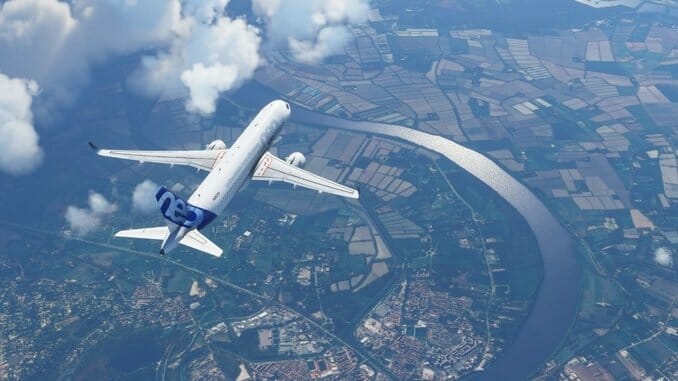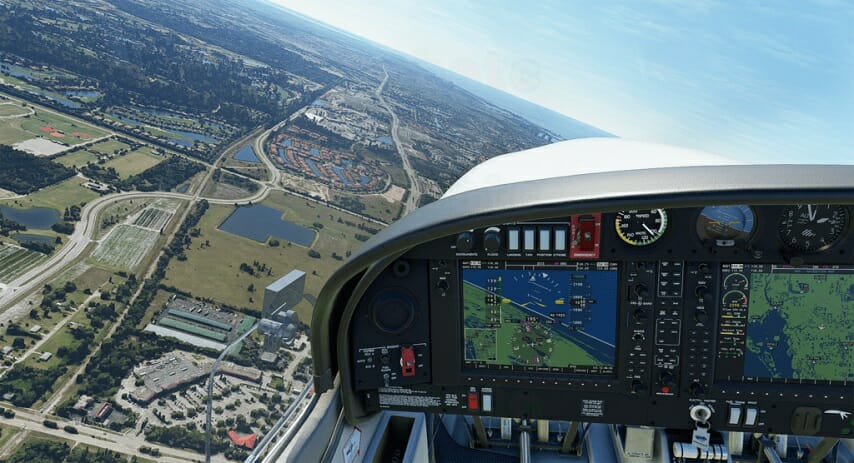Microsoft Flight Simulator Is Back, and It’s Brought the Pre-Pandemic World With It

I’m old, but I’ve never felt Flight Simulator old. Those things aren’t really games, in the traditional sense. They’re a full-fledged hobby, and I use that word in the mustiest way possible. You should only be able to buy flight simulators at one of those weird stores that didn’t even try to come up with a name and just settled on “hobby shop” that used to exist in every mall in the ‘80s. Flight sims always felt like a weird mix between model train sets, ham radio, and Civil War reenactments, things that will always and forever be popular only with men over the age of 40.
Well, shit. Guess how old I am now.
Microsoft Flight Simulator has arrived at the perfect moment, and not just because I’ve reached the age where everything aches all the time. The tech giant’s iconic flight sim hasn’t been seen in these parts since 2006, but its legacy stretches back to 1982, to the primordial brown and beige days of personal computing. Yes, Microsoft Flight Simulator is almost old enough to play itself. There’s no way Microsoft could’ve known its first flight simulator in a generation would come out amidst a pandemic that has almost killed the travel industry—at least, there’s no way Microsoft could’ve known that unless those absolutely unhinged conspiracy theories about Bill Gates are true (THEY AREN’T)—but there’s never been a better time to simulate the experience of flight.
I used to travel a lot. I used to fly two or three times a month. I haven’t gone farther than 10 miles from my house in almost half a year. I am losing my mind.
Fortunately Microsoft Flight Simulator is here to help. The first time I played it (“play” really isn’t a good word here; the first time I booted it up? Enveloped myself in it? Revved its engines?) I loaded up a night flight between Atlanta and Orlando, put it on autopilot, turned off the lights to my office, and just listened to the sounds of the jet around me while looking out the window at the simulated lights below. Sometimes I’d look at my phone. All it needed was a tiny screen showing an action movie I didn’t really care about in front of me—and a smaller screen two rows ahead, silently showing a different movie to a different passenger, that I’d wind up paying more attention to.
It was a small moment of peace during what has otherwise been a catastrophic year.

That computerized flight was far more comforting than it should have been. From the concept to the actual process, flying is an inherently uncomfortable thing; you stand around for hours in the largest waiting room you’ve ever seen, just to sit in a deafening hallway full of recycled air tens of thousands of feet high, and inevitably wind up in Salt Lake City. But anything can turn into a routine if you do it enough, and when routines get disrupted it’s natural to yearn for their return. For the restoration of what we know.
We’ve all been stuck in a new routine since March, a veritable rut of housebound inaction and virtual interaction that is a poor substitute for actual living. (And if you haven’t been living in that rut, I’m guessing you’re one of those selfish assholes who aren’t taking this virus seriously and have ruined the recovery timeline for the rest of us. Get bent.) Anything that can restore even a semblance of pre-pandemic life is valuable right now, and that’s the greatest thing about Microsoft Flight Simulator: the world it recreates is one without the pandemic. Its glimpse of the old life might be fleeting and intangible, a mere mirage on the skyline, but it’s still powerful, and in a way that can’t be matched by movies, books, games, or moping listlessly through a Target for 15 minutes while wearing a mask.
Microsoft Flight Simulator is a technological marvel, with a variety of innovations that make its virtual world as faithful to our real one as possible, and I have no idea how any of it works. All I know is it involves cloud computing. I have spent my entire adult life purposefully not learning anything about “cloud computing.” If this particular development in computer science existed solely to make those 30 minutes of solace in my office possible, it was all worth it.
Forget the technology, though. The most important thing about Microsoft Flight Simulator is that it’s become an unlikely emotional support system. It connects us to something we can’t currently touch or feel, something we’ve been sorely missing, which is a sense of normalcy. Yeah, it’s an illusion. Yeah, it’s disappointing to take those headphones off and look up from the monitor and realize I’m back in the same house I haven’t left in half a year. And I know I’ve been enormously blessed and privileged so far—me and my family have been able to avoid the virus, despite living in one of the highest risk parts of the country, and of all the things to complain about during a pandemic, “not being able to fly” is near the bottom of the list. But when I’m in that digital cockpit all that stuff fades away, and it takes my stress and depression along with it, at least for a little while. And that’s worth something.
Hell. Now I’m thinking I should give ham radio a shot.
Senior editor Garrett Martin writes about videogames, comedy, music, travel, theme parks, wrestling, and anything else that gets in his way. He’s on Twitter @grmartin.